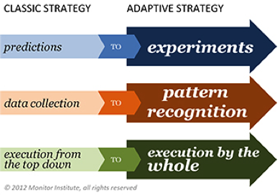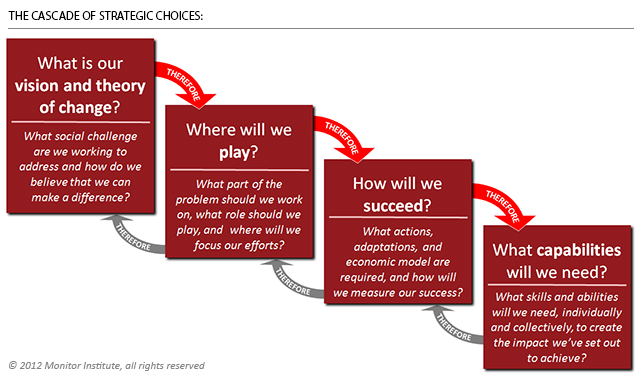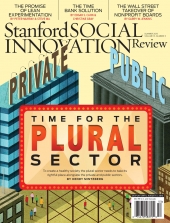The Strategic Plan is Dead. Long Live Strategy.
In today’s fast-changing world, why freeze your strategic thinking in a five-year plan?
Take a moment and read these two words: strategic plan. Now close your eyes and picture one. If what comes up is a thick binder, gathering dust on a shelf next to other thick binders from five and ten years past, you’re not alone. We believe that a better understanding of the history of strategy and what caused the demise of binder-bound strategic planning can point the way to re-inventing strategy for the world we live in today. It is important to remember that strategy’s roots are military. Military strategy focuses on setting objectives, collecting intelligence, and then using that intelligence to make informed decisions about how to achieve your objectives—take that hill, cut this supply line.
Historically, the battlefield was a place where you could count on a few constants:
- The past was a good predictor of the future. There were years or decades between meaningful shifts in the basic variables, such as the power of a soldier’s weapons or the range of aircraft.
- Good data was scarce and hard to come by. Scouts and spies had to risk their lives to find and relay information, and had to be ever on the lookout for enemy deception.
- Lines of communication were unreliable at best. Small numbers of clear directives were a tactical imperative.
Not surprisingly, after a couple of millennia, military strategy became well adapted to these constraints.
After World War II, when military strategy came into the business world as strategic planning, so did these constraints. As a result, strategic planners focused on predicting the future based on historic trend lines; invested heavily in gathering all available data; and produced a small number of directives issued from the top, for the rest of the organization to execute.
This approach to strategic planning was a reasonably good fit for much of the business world from the fifties through the eighties. But with the rise of high-tech tools and increased globalization in the nineties, the world began to change, and now it looks quite different indeed. The future is no longer reasonably predictable based on the past—in fact, it is liable to be startlingly different. Good data is easy to access and cheap to acquire. Communication is rapid, indiscriminate, and constant.
The world has become a more turbulent place, where anyone with a new idea can put it into action before you can say “startup” and launch widespread movements with a single Tweet. This has left organizational leaders with a real problem, since the trusted, traditional approach to strategic planning is based on assumptions that no longer hold. The static strategic plan is dead.
This has led to increasingly polarized attitudes about the value of having a strategy at all. Some leaders are valiantly trying to save strategic planning by urging us to focus even more on rigorous data analysis. Others deny the value of strategy, arguing that organizations need agility above all else (an attitude that famed strategist Roger Martin reports hearing with increasing frequency).
We think that what is necessary today is a strategy that breaks free of static plans to be adaptive and directive, that emphasizes learning and control, and that reclaims the value of strategic thinking for the world that now surrounds us. Martin acknowledged this point at the Skoll World Forum in 2010 when he said: “Every model is wrong and every strategy is wrong. Strategy in a way helps you learn what is ‘righter’. People think you can prove a strategy in advance. You can’t.”
The approach we developed in working with our clients at Monitor Institute is what we call adaptive strategy. We create a roadmap of the terrain that lies before an organization and develop a set of navigational tools, realizing that there will be many different options for reaching the destination. If necessary, the destination itself may shift based on what we learn along the way.

Creating strategies that are truly adaptive requires that we give up on many long-held assumptions. As the complexity of our physical and social systems make the world more unpredictable, we have to abandon our focus on predictions and shift into rapid prototyping and experimentation so that we learn quickly about what actually works. With data now ubiquitous, we have to give up our claim to expertise in data collection and move into pattern recognition so that we know what data is worth our attention. We also know that simple directives from the top are frequently neither necessary nor helpful. We instead find ways to delegate authority, get information directly from the front lines, and make decisions based on a real-time understanding of what’s happening on the ground. Instead of the old approach of “making a plan and sticking to it,” which led to centralized strategic planning around fixed time horizons, we believe in “setting a direction and testing to it,” treating the whole organization as a team that is experimenting its way to success.
This approach wouldn’t surprise anyone in the world of current military strategy. Recent generations of military thinkers have long since moved beyond the traditional approach, most notably famed fighter pilot John Boyd. He saw strategy as a continuous mental loop that ran from observe to orient to decide and finally to act, returning immediately to further observation. By adopting his mindset (with a particular emphasis on the two O’s, given our turbulent context), we can get much better at making strategy a self-correcting series of intentional experiments.
To provide structure to this fluid approach, we focus on answering a series of four interrelated questions about the organization’s strategic direction: what vision you want to pursue, how you will make a difference, how you will succeed, and what capabilities it will take to get there.

The skills and mindset for today’s strategic planning will come from continuously asking ourselves these questions about our organizations, programs, and initiatives. Once we accept Dwight D. Eisenhower’s sage advice that “Plans are useless, but planning is everything,” we will be ready to adapt to whatever curveballs the twenty-first century sees fit to throw.


 Dana O’Donovan (@DanaODonovan) is the COO of Monitor Institute and is fascinated by the border between strategy and execution, where seemingly incremental changes in day-to-day behavior can enable individuals, organizations and collectives to achieve breakthrough social change. Her consulting practice at Monitor Institute focuses on identifying opportunities, developing strategy, designing organizational and activity systems, helping organizations learn, and facilitating groups through periods of transition.
Dana O’Donovan (@DanaODonovan) is the COO of Monitor Institute and is fascinated by the border between strategy and execution, where seemingly incremental changes in day-to-day behavior can enable individuals, organizations and collectives to achieve breakthrough social change. Her consulting practice at Monitor Institute focuses on identifying opportunities, developing strategy, designing organizational and activity systems, helping organizations learn, and facilitating groups through periods of transition. Noah Rimland Flower (@MntrInstitute) works with leaders to achieve large-scale social change through new uses of collaboration, networks, and technology. Over close to a decade of work at Monitor he has combined consulting and research to develop new strategies on issues including education reform, healthy food systems, and climate change.
Noah Rimland Flower (@MntrInstitute) works with leaders to achieve large-scale social change through new uses of collaboration, networks, and technology. Over close to a decade of work at Monitor he has combined consulting and research to develop new strategies on issues including education reform, healthy food systems, and climate change. By adopting a model from business, nonprofit organizations can launch, test, and implement new programs and services more efficiently.
By adopting a model from business, nonprofit organizations can launch, test, and implement new programs and services more efficiently.  If we want the nonprofit sector to innovate, we need to acknowledge the gender gap between nonprofits and the private sector.
If we want the nonprofit sector to innovate, we need to acknowledge the gender gap between nonprofits and the private sector.
 Three principles for solving complex, systemic problems like improving community health.
Three principles for solving complex, systemic problems like improving community health.
 As the momentum of impact investing builds, the lack of proper taxonomy poses a significant risk to the movement, especially given recent growth.
As the momentum of impact investing builds, the lack of proper taxonomy poses a significant risk to the movement, especially given recent growth.
 Why a recent exposé on Red Cross failures in Haiti highlights unrealistic expectations for social sector organizations.
Why a recent exposé on Red Cross failures in Haiti highlights unrealistic expectations for social sector organizations.
 Marketing professor Jennifer Aaker shows how stereotypes can be reframed to influence consumer behavior for nonprofits.
Marketing professor Jennifer Aaker shows how stereotypes can be reframed to influence consumer behavior for nonprofits.
 How to maintain membership lists without a lot of operations money: Whitcanack on BigTent.
How to maintain membership lists without a lot of operations money: Whitcanack on BigTent.
 Challenges nonprofit professionals face in an increasingly fast-paced, demanding world.
Challenges nonprofit professionals face in an increasingly fast-paced, demanding world.
 Why are so many nonprofits in a perpetual starvation cycle? How capacity building and systems are crucial nonprofit building points.
Why are so many nonprofits in a perpetual starvation cycle? How capacity building and systems are crucial nonprofit building points.
 Four practices that can help people establish common intent; sense emerging needs and solutions; and collectively prototype, create, and evolve innovative health models and relationships.
Four practices that can help people establish common intent; sense emerging needs and solutions; and collectively prototype, create, and evolve innovative health models and relationships.




COMMENTS
BY AJ
ON January 10, 2013 01:26 PM
What a great article! There’s such a movement in the industry toward the utilization of more and more agile tools, but there are still elements of the ‘old ways’ that even those of us who have a hand in building said tools are unreasonably married to- I’m the chair of the strategic planning committee for the non-profit whose board I serve on and we’ve been struggling away at the same old type of strategic plan for the past three months. This article really gave me some food for thought about why- even with diligent, experienced application of skills and energy- we haven’t been making much headway. The ‘cascade’ of strategic choices in particular was helpful in opening up my thinking about our foundational approach to building the plan and the ways in which it needs to change. Thanks for the terrific post!
BY TITO HERNANDEZ
ON January 11, 2013 07:04 AM
Excellent article!!
In currents time, we must play with trends and escenaries
BY sfrisch, Sierra Business Council
ON January 11, 2013 07:21 PM
Amazingly our organization is in the process of reviewing and updating our strategic plan, and come to the conclusion that we did not need a plan; we needed a system to focus our vision, choose the correct situational strategy, execute, measure progress, adapt to what we have learned, and re-focus it on other problems. This article put in a few simple words and graphs the iterative process I have been trying to capture for the last 2 months. Kudos to the authors, incredibly helpful!
BY Juan Gironella
ON January 12, 2013 12:52 AM
Absolutely agreed. There’s no doubt companies need a faster and more empiric way of seeing business. I strongly recommend any entrepreneur / manager reading this article to further understand this new way of gathering information and analyzing strategy to read “The Lean Startup” by Eric Ries; an outstanding book strongly related to this matter.
BY Peter Giesen
ON January 12, 2013 06:04 AM
Great article!. Its nice to see Eisenhower referenced, but it would be appropriate to cite Clausewitz, the father of modern military strategy and the concept of evolving strategy.
BY Debi Davis
ON January 12, 2013 07:55 AM
I’m a strategy geek, and found this article to be brilliant. I particularly like the concise “Cascade of Strategic Choices.”
I find that adding an element of “who” is helpful. E.g., Who are we trying to reach / help? Who will be our strongest advocates? Answering these questions might help to focus the answers to the “what,” “where” and “how” questions.
Also, loved the Eisenhower quote!
BY Richard Childs, Magellan Training Consulting
ON January 13, 2013 05:50 AM
Elegant and Debi Davis adds value with the “who” analysis. Deloitte Consulting says 80% of change failure is attributable to human factors.
The “who” has several other dimensions both external and internal
Externally, we need to understand and position our strategy relative to alternative sources of the services.
Internally, stakeholder analysis determines, vis-a-vis the status quo and change, who has something to win, lose, the risks and consequences associated, then “get-on-side” strategies. Then stakeholder engagement is a crucial factor.
De facto this integrates change management and raises the probability of successful strategic change.
BY Starlyn D'Angelo
ON January 17, 2013 08:33 AM
This is very interesting food for thought. Non-profit organizations who wish to use this approach may find it difficult as many funding entities require that we submit a traditional strategic plan as a part of our application package.
Perhaps we could take a gamble and submit a plan based upon the cascade of strategic choices and see what happens. Having sat in on several grant review panels, I know that the process is tightly controlled in the interest of providing a “fair” review. However, some funders may be more open minded if they see more non-traditional plans.
BY Julie Simpson
ON January 18, 2013 07:36 AM
BY: Julie Simpson and Chris Cardona, TCC Group
Great piece! We’re big fans of an adaptive approach. For us, strategy is a framework for decision-making. It’s a tool for managing uncertainty and change—but always based on a hard-earned clarity that underlies an organization’s mission. Strategy also provides the filament that connect an organization’s everyday activities to the big-picture outcomes that motivate staff and attract donors – via shorter-term, more “realistic” outcomes the organization can have more direct control (there’s that word!) over.
Speaking of prediction: Nate Silver talks about tapping into your inner Bayesian – an approach to statistics that’s about stating your “priors,” your assumptions, then continuously updating them based on new information. Good strategy means tapping into your inner Bayesian, in the sense of getting crystal clear on your “priors,” and then setting up systems (that become part of your day-to-day approach to your work) so you can continuously update them based on new information.
Thanks for sparking an enjoyable discussion! Starlyn, your point is particularly important. Funders should be looking for your ability to be strategic, that capacity. It’s more important than a document. (Though those are useful too.)
BY Ranjan Paul
ON January 18, 2013 09:09 AM
Great article.
BY Lester Olmstead-Rose, La Piana Consulting
ON January 18, 2013 04:38 PM
We couldn’t agree more! Developing strategy in real-time takes strategic thinking, not strategic planning. We’ve pushed for years for nonprofits to focus more actively on building strategy first, and developing tools to apply strategic decision-making in real time, rather than every few years. We’re excited to see the sector continuing to embrace more dynamic and responsive approaches to strategy development.
BY Chantal Cholette
ON January 21, 2013 04:37 AM
Quite interesting indeed. I’ve been encouraging organizations to integrate strategy in day to day practice for years. Your article offers a framework to do so in a fluent, organic method. Thank you for your contribution.
BY Gerald Nanninga
ON January 21, 2013 04:37 AM
Another question I would add to the mix is “what is my advantage?” In a world where everyone is just chasing and experimenting, it is easy to just run after business fads with no discernible advantage. Being in the right place with no advantage doesn’t gain you much.
BY Shayne Wyler
ON January 21, 2013 08:25 AM
Great insight Dana and Noah.
Thank you for sharing this.
To realize your value in the lives of those you serve, the four questions you ask are excellent. We here at Seven, follow a similar process, to clarify your direction, build a culture of we and structure for sustainability.
Again thank you for sharing your insight.
BY Kira McGurrin
ON January 21, 2013 01:53 PM
Nice piece. You caught the essence of what I have been thinking about for months and gave it a cool visual. It is a bit like Agile project management with scrums…that is like how I like to think about it. There is a place for it in everyone’s business. Many people are still living life, like tomorrow will be the same. Wait a day, tomorrow can bring new opportunities and perhaps a looking at the problem from a different angle will provide answers never thought possible.
BY Delia Clark
ON January 23, 2013 03:24 AM
Really helpful! Do you have thoughts about how this could be adapted to groups working on strategic planning for collective impact?
BY Dennis Dugan
ON January 24, 2013 01:11 PM
I think it was Michel Robert who opined that strategic planning is really the periodic formalization of the current state of strategic thinking.
And, that, strategic thinking is synthesizing what we already know and what we learn into a perspective about the direction the company should follow. Synthesizing is the combining of often diverse concepts into a coherent whole. Strategic thinking is also an intuitive and creative process. Therefore it can’t be fully developed ‘on schedule’. The outcome of strategic thinking is an integrated perspective of the enterprise, a not-too-precisely articulated vision of direction.
Those Robert comments synch well with this article.
BY S Graubart
ON January 26, 2013 01:50 PM
This sounds very similar to the old debate between deliberative vs. emergent strategy.
See: http://www.forbes.com/sites/karlmoore/2011/03/28/porter-or-mintzberg-whose-view-of-strategy-is-the-most-relevant-today/
BY Gregory Kurth
ON January 31, 2013 11:56 PM
The article makes a great case for strategic thinking over static strategic plans. Nevertheless, I think organizations must clarify their strategic intent. Strategic intent helps to identify that sweet spot, that differentiating component that makes the actions of your mission distinct. It helps to define what you do as well as what you won’t do. When this is clear, organizations can be begin operationalizing their activities, whether or not they are deeply ingrained in a plan.
BY Peg Gillard
ON February 2, 2013 06:59 AM
We need to apply this to the current system of public education. It is stuck in an historical time vapor-block.
BY Kevin Cahill
ON February 6, 2013 06:16 AM
What a great article on the need for organizations to be adaptive and experimental. This is a huge shift for so many companies I work with. Understanding that change is a good thing and will happen continuously, rather than a trying to set a static path to an unknown future is not only the right thing to do, it creates a culture of learning.
BY R Y Madkaikar
ON February 13, 2013 09:50 PM
The article is very good signifying the adaptive approach. But beyond the “OODA” concept, one more thing I wish to add i.e. Tracking. You have to understand where your strategy is going to take you. In order to understand that you need to have a sound understanding of who your Customer is. If one can understand that, then although the product life cycle has shorten I feel that Strategic Planning can still work wonders.
BY Loren Harris
ON March 15, 2013 11:30 AM
Thanks to the authors for an interesting article that raises important points about the long-standing need for organizations/people to be adaptive. However, one should be cautious about presenting false choices. Strategic planning in any setting, military, corporate, nonprofit was never meant to be static. Effective organizational leadership is, and has always been, about adapting to change and using information to make decisions. These are principles that hold whether one starts a social media movement or leads a fifty-year old agency. Certainly, new technologies increase the scale and speed at which information is available and actions can taken but this has been true with every major technological advance. Whether a strategic plan or adaptive planning an organization has to be flexible, cognizant of an ever-changing environment and able to use information/data to make decisions that advance the organization’s goals or vision of success.
BY Tyra
ON March 19, 2013 07:37 AM
Great article! Along similar lines of the book good strategy/bad strategy
BY Carl Bordeaux
ON March 20, 2013 03:22 AM
Great article!
BY Ginny Lang
ON March 20, 2013 12:29 PM
I agree—great article. It’s always been the case that any plan that goes into a drawer is useless and it’s also always been the trick to figure out the best way to make a plan a living document that can adapt to the changing environment. I like this article because you talk about constantly asking questions and not being afraid to get answers that differ from the conventional wisdom. Thank you!
BY James Movich
ON April 3, 2013 01:13 PM
Good Article…
I tend to agree with Debi - processes don’t do things, people do, and without the “who” there seems to be a component missing.
I also think the change from data collection to pattern recognition in adaptive strategy could lead to the possible (and logical?) progression of pattern recognition to anticipated outcome, allowing for faster responsiveness and execution.
BY Mwinyikione Mwinyihija
ON April 9, 2013 01:05 AM
amazed with the emerging theorem in retrospect to strategic plans! Its refreshing and provides an impetus to newer thinking in strategic planning! In Africa we are still stuck with plans due to donor conditionality as a prerequisite - Time to change I think!!!!
BY Barbara Kates
ON April 10, 2013 11:31 AM
Many of us who assist organizations in planning have moved in this direction. Thank you for succinctly describing where we are going for us. I also think a key part of today’s plan is building a network of support to help carry your organization through the good times and the tough times.
BY Prof. Anjali Vamburkar
ON May 5, 2013 12:22 AM
Good article indeed! I have one addition though.. Can we add one more dimension to the graph of “Cascade of Strategic choices”? I think defining the time constraints for achieving the strategic goals is equally important. The last step in the cascade could be the time line definition. This will give a concrete target which can be measurable.
BY Maria Katrien Heslin
ON June 17, 2013 03:46 PM
Fine article. Let’s face it, a good strategic plan is only as effective as the individuals and organization who create it. If a plan fails or is considered to be written in stone, that isn’t the plan’s fault, it is the fault of the thinking-within-the-box people who put it together and are implementing it. Instead, an excellent strategic plan is one that should be continually reviewed, discussed, kept in front of staff, communicated, evaluated, altered, measured and made very visible to all stakeholders.
BY Rodney Brim
ON August 2, 2013 04:10 PM
Dana and Noah, just saw your blog so am chiming in late. Thanks for writing, great content. Very much agree with the premise. Actually I beginning to occupy the space that sees strategic planning as an oxymoron. Companies who do it are typically not strategic, and they don’t follow the plan… which then leads to the question of what is a strategic plan actually providing for most organizations? Maybe a sense of comfort or being in control. While musing on that, two additional points.
1. I think the work strategic planning needs to be reworded to get traction. I was just working in a vertical, in which the majority of organizations believe strategic planning is a waste of time and effort.
Curious about your thoughts, but I’ve been having fun with putting the word “Tentative” in front of strategic plan, e.g. needing regular testing, validation and confirmation we’re still on the right track. I’ve stated it a bit better in this blog: http://rodneybrim.com/think-strategy-think-risky-assumptions
2. I think your opening strategy question is something a consultant might ask, but not 99% of the businesses I work with. Their strategy is about how to grow. And if they are non-profit, it bounces between mission and back to how to acquire funds. I could be off-track, but I know the first step is key in every process, as it is in strategic planning.
I usually boil strategy down to one singular first step, defining how to grow the business based upon an analysis of the market first, internally second. A little more on that on this blog: http://rodneybrim.com/starting-your-strategic-plan-on-the-right-foot
BY Yakubu Ochefu
ON August 10, 2013 02:34 AM
Great article. I am in the process of auditing the first year performance of my 5 year vision plan for my University. Your article has given me a template that will defiantly improve on what we set out to do last year.
BY Michael Jacobson
ON September 13, 2013 10:00 AM
I completely agree with the premise and the concept, however…I don’t see this brave new world of easy to collect data, effective communication, and strategic orientation in my daily world. Yes, centralized top down planning feels outmoded but the skills, systems and mindset to move to this approach imply an organizational nimbleness and agility that I rarely see in the real world. Would love to know what factors the authors see as preconditions for pursuing this approach. What skills need to be present? What systems are assumed? The overwhelming flow of data (note I did not say “information” which implies that is is value added and understandable) makes coming to agreed upon direction, much less implementing that direction harder, not easier. I think a systems appraoch is vital for any strategic work to advance. Appreaciate the provocoative premise and the conceptual construct.
BY Richard Brown
ON October 3, 2013 07:15 AM
Excuse me for saying this, but frankly I’m struggling to understand why this article has attracted quite so much positive endorsement.
It’s clear and nicely written for sure, but what exactly is new here?
It must be the clients I work with, few of which would find anything in the article to disagree with, precisely because most of them moved way beyond ‘the strategic plan’ as a static, formulaic annual ritual some considerable time ago.
On a more positive tack, explicitly featuring capabilities in the ‘cascade of strategic choices’ is certainly helpful. Many clients still struggle to understand the concept of ‘capability’, and saddle themselves with unworkable strategies as a result.
BY john luo
ON November 5, 2013 07:31 PM
Excellent article, sorry to read it late!
BY Tim Merritt
ON December 17, 2013 07:31 AM
Excellent article and I agree with other comments regarding the importance of clearly defining Strategic Intent within an organization. In my experience, a tactical roadmap has a predetermined destination which discourages strategic thinking and agility. Strategic intent offers a framework for creative thinking and solutions that otherwise may never come to light.
Thanks!
BY Charles Chapman
ON December 17, 2013 12:39 PM
Late to the party. I like the article because it reiterates the strategic planning (broad plan and roadmap) and execution tension I’ve dealt with as a CIO since the early 2000s; moving strategic review (strategic thinking) into the operational world of business, adjust compass heading and review alternatives with tradeoffs when necessary, and ensure the strategic partnerships are intact as we continue forward. I like the point of ‘cascade of strategic choices’. Collapsing the strategic intent with the speed of thought to achieve the vision. Then adapt when necessary – ensuring relevance to the customer. Thanks for the stimulus.
BY Jim Williamson
ON January 8, 2014 01:56 PM
I’ve read this article multiple times since it was published in January 2014, and I love it more every time. Couple the article’s major thesis with Peter Sim’s brilliant book, Little Bets, on fostering creativity & innovation as a means to testing your strategies and I believe you’ve got both the What & the How of the dynamic operating environment we’re all seeking.
BY Sophia Walker
ON January 10, 2014 12:48 PM
Great article. There is no one-size fits all solution for any business. Strategic planning still works for some and it can’t be completely discounted just because there are tools or purportedly better ways.
BY Burk Semelvise
ON May 23, 2014 02:08 PM
LOL—- chucking the SP works in a vacume but not in the real world of execution by employees—they need the plan from which to execute the tactics to drive the vision/strategy.
There is nothing new under the sun—- Zzzzzzzzzzzzzzzzzzzzzzzz
BY M. Blenkower
ON July 23, 2014 11:00 AM
Great work. Thans for the article.
BY Tim Dutton
ON July 27, 2014 10:59 PM
Great article and very much in sync with McKelvey’s (and others) work on complexity theory and strategic planning.
BY Shobha Gowri
ON August 16, 2014 08:52 PM
Great article.We were in the process of working on the strategic planning for our NGO when I found this writeup.It made a world of change to the way I looked at the strategizing process and made it so so much more exciting to think through it all.
The adaptive strategies suggested made the whole process vibrant and organic .The cascading model gave me the framework to crystallize my thoughts
Thank you
BY sonalika
ON August 21, 2014 10:21 AM
Great article . The adaptive strategies suggested made the whole process vibrant and organic .The cascading model gave me the framework to crystallize my thoughts
I am in search of this statement “strategic intent designs the success path of organisation” by highlighting with four phases of strategic management. can any body help me defining /justifying this statement. so that it makes me worth for justification.
BY Nick
ON August 31, 2014 01:54 PM
So what this really says is: “Your plans may change upon further developments.” Wow, that is just a stunning insight. What about just saying that in plain English?
Better yet, why not just forego all this C-level business school bloviating and just DO YOUR WORK? Far too much time is spent on strategic plans, mission statements, goal statements, and related gibberish.
BY Tim Dutton
ON August 31, 2014 07:53 PM
Nick, sounds like frustration in a quest for practical and something with impact. I get it. I also believe Curt Lewin’s quote, “There is nothing more practical than a good theory.” Lewin was imploring theorists to identify new ideas that might suggest new ways to deal with REAL problems. And those involved in practical applications should offer up enough data for theorists to keep at the process of theory and fine-tuning.
I find this process stimulating but only, as you say, if it focuses on real change and especially if it gives me some insight or reinforces some of my suspicions.
Glad you are reading SSIR? Seems like a good place for this discussion.
BY Nick
ON September 2, 2014 04:43 PM
Well, this isn’t really a theory (for the record, a theory is a falsifiable set of causal generalizations). “Falsifiable” means that something can be tested with data. What are the testable propositions here?
One other thing: if “adaptive” planning means that a plan is constantly modified, how is it still a PLAN?
BY Greg Wilson
ON October 10, 2014 11:53 PM
Mike Tyson of course had the right quote on planning.
“Everyone has a plan and then they get punched in the face”
So have a plan, nothing wrong with that, but make sure you can update it, based upon sound analysis ie you don’t change it on a whim. Constant changing is a sign of dysfunction.
I agree wholeheartedly with the plea for plain English and to get rid of the business school gobbledegook
Greg Wilson, Cranfield University
BY Ahmad Palladan Aliyu
ON November 16, 2014 02:35 AM
Good! What an article; that reminds me on one time lecturer during my undergraduate days!
A nice piece indeed!
BY Maria Scott
ON December 20, 2014 12:03 AM
praiseworthy…....really this is an emerging fact as earlier business strategies or plans may not match or be efficient at present under the dynamic prospectus of business field. One of my childhood friend, a renowned businessman desired for a revision and change. He had got many references, but among of all OGS Capital, one of the leading Business planning company based in USA had made his dreams come true. I personally appreciate the expertise and quality of the planners and other professionals of OGS Capital. They have also highlighted the theory of dynamics and modifications.
BY John
ON December 23, 2014 02:53 PM
I’m a strategy geek, and found this article to be brilliant. I particularly like the concise “Cascade of Strategic Choices.”
I find that adding an element of “who” is helpful. E.g., Who are we trying to reach / help? Who will be our strongest advocates? Answering these questions might help to focus the answers to the “what,” “where” and “how” questions.
Amazingly our organization is in the process of reviewing and updating our strategic plan, and come to the conclusion that we did not need a plan; we needed a system to focus our vision, choose the correct situational strategy, execute, measure progress, adapt to what we have learned, and re-focus it on other problems. This article put in a few simple words and graphs the iterative process I have been trying to capture for the last 2 months. Kudos to the authors, incredibly helpful!
BY mattwatson
ON January 27, 2015 05:30 AM
More analytical post. It is very true that there was a time when business plans were made before the foundation of a company, it had been continued forever, but the picture has been changed. At present the dynamics of technology needs more effective planning connected to reality which means revision basis planning. In this concern I am suggesting the name of OGS Capital as they have supported me in a better manner for the prosperity of my business. Thanks to OGS Capital.
BY Ricky Margan
ON February 3, 2015 03:35 AM
More informative one. It is very clear that the strategic plans are not working due to the high dynamics of technology and market strategy. A business plan made will also have to be revise time to time to keep it stable with condition of the market. The matter has become more complicated. When I was thinking about the same I found TS Business Plan who had finally fixed my headache. Now I am leading my business in a better way. Thanks to TS business plan.
BY MarcioWilges
ON February 10, 2015 11:07 PM
It is indeed very true – I did visualize a dusty and thick book dumped in the archive section the moment you mentioned strategic plan. I personally agree that the concept has died down and is almost becoming as a thing of the past, now that a newer and better theory has emerged. It is time for removal of the old topics and open up an entirely new chapter to accept this new introduction to strategy on its own.
BY Linda Simmons
ON February 23, 2015 04:36 AM
In short set the goal, analyze the situation and make decision analytically instead of traditionally. However it also helps if create some small objectives and do reward us when achieving them. This keep the enthusiasm and gives us the sense of progress or achieving something. Just my 2cents.
BY Porsche Crooks
ON March 17, 2015 07:58 PM
Such a great article! I personally find that great opportunities for change and forward growth are lost because of strategic plans that are stringent. If only State Gov. Departments would start thinking like this…
BY Alison Brewin
ON March 26, 2015 12:32 PM
A great article, but many non-profits don’t have the kind of resources to fully engage staff and stakeholders on a regular enough schedule to maintain the kind of iterative process you describe, and if Board and ED are doing it on their own, problems will emerge. I did a video to help organizations understand what to use a strategic plan for, so they can develop one that works and not to hand to a funder or certifying body. To me that is actually the key to making strategic thinking a regular part of the work.